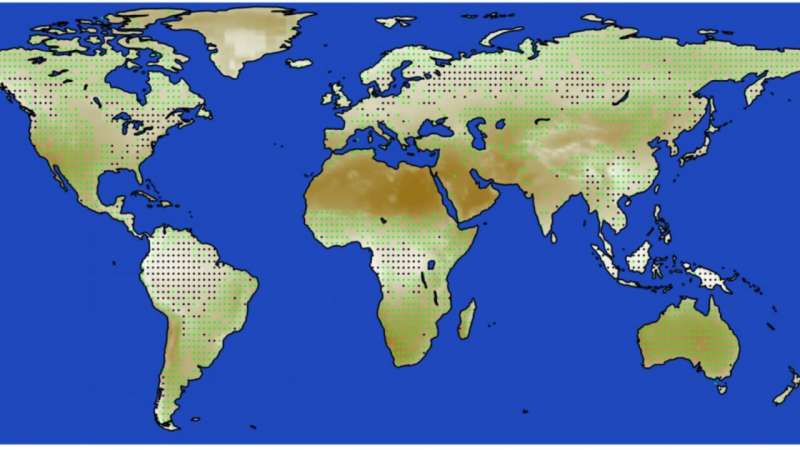Planting forests may cool the planet more than thought

Planting trees and replenishing forests are among the simplest and most appealing natural climate solutions, but the impact of trees on atmospheric temperature is more complex than meets the eye.
One question among scientists is whether reforesting midlatitude locations such as North America or Europe could in fact make the planet hotter. Forests absorb large amounts of solar radiation as a result of having a low albedo, which is the measure of a surface's ability to reflect sunlight. In the tropics, low albedo is offset by the higher uptake of carbon dioxide by the dense, year-round vegetation. But in temperate climates, the concern is that the sun's trapped heat could counteract any cooling effect forests would provide by removing carbon dioxide from the atmosphere.
But a new study from Princeton University researchers found that these concerns may be overlooking a crucial component—clouds. They report in the Proceedings of the National Academy of Sciences that the denser cloud formations associated with forested areas means that reforestation would likely be more effective at cooling Earth's atmosphere than previously thought.
"The main thing is that nobody has known whether planting trees at midlatitudes is good or bad because of the albedo problem," said corresponding author Amilcare Porporato, Princeton's Thomas J. Wu '94 Professor of Civil and Environmental Engineering and the High Meadows Environmental Institute. "We show that if one considers that clouds tend to form more frequently over forested areas, then planting trees over large areas is advantageous and should be done for climate purposes."
As anyone who has felt a cloud pass over the sun on a hot day knows, daytime clouds have a cooling—albeit transient—effect on the Earth. In addition to directly blocking the sun, clouds have a high albedo, similar to ice and snow. Clouds, however, are notoriously difficult to study and have been largely discounted from many studies examining the effectiveness of natural climate change mitigation, including reforestation, Porporato said.
To consider reforestation in the context of cloud coverage, Porporato worked with lead author Sara Cerasoli, a Princeton graduate student in civil and environmental engineering, and Jun Ying, an assistant professor at Nanjing University of Information Science and Technology who previously was a postdoctoral fellow in Porporato's research group. Their work was supported by the Carbon Mitigation Initiative based in HMEI.
Porporato and Yin previously reported that climate models underestimate the cooling effect of the daily cloud cycle. They also reported last year that climate change could result in increased daily cloud coverage in arid regions such as the American Southwest that are currently ideal for solar power production.
For the latest study, Cerasoli, Porporato and Yin investigated the influence of vegetation on cloud formation in midlatitude regions by combining satellite data of cloud coverage from 2001-10 with models related to the interaction between plants and the atmosphere.
The researchers modeled interactions between different types of vegetation and the atmospheric boundary layer—which is the lowest layer of the atmosphere and interacts directly with the Earth's surface—to determine whether cloud formation is differentially affected by vegetation type. They focused on regions in the 30-45 degree latitudinal range, roughly from the subtropics to the hemiboreal zones such as the northern Midwestern United States. They considered the effects of both reforestation—restoring lost tree cover—and afforestation, which entails planting forests in areas that were previously treeless, though this may come with other environmental costs.
The team found that for midlatitude regions, the cooling effect of clouds—in combination with that of carbon sequestration—outweighed the solar radiation that forested areas absorbed.
The models showed that clouds form more frequently over forested areas than over grasslands and other areas with short vegetation, and that this enhanced cloud formation had a cooling effect on Earth's atmosphere. The researchers observed from the satellite data that clouds also tend to form earlier in the afternoon over forested areas, which results in a longer duration of cloud cover and more time for clouds to reflect solar radiation away from the Earth.
The findings could help develop policies for allocating land for reforestation and agriculture—wetter midlatitudinal areas such as the eastern United States or southeastern China are well-suited to reforestation and afforestation, but also are appealing for agriculture. One approach would be to pair midlatitudinal reforestation with the distribution of drought-tolerant crops for regions less suited to reforestation, the study authors reported.
However, the authors urged that we must be cautious when making the leap from science to policy. "We can't just consider climate change, but must also consider other factors, such as biodiversity and the fact that land is also needed for food production," Cerasoli said. "Future studies should continue to consider the role of clouds, but should focus on more specific regions and take their economies into account."
"The first thing is to not make things worse," Porporato added. "So many things are connected in the earth system. The nature of interactions between, for example, the water cycle and climate mean that if you change one thing, it's very difficult to predict how other parts of the system will be affected."
The paper, "Cloud cooling effects of afforestation and reforestation at midlatitudes," was published Aug. 9 in the Proceedings of the National Academy of Sciences.
No comments:
Post a Comment